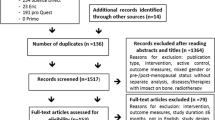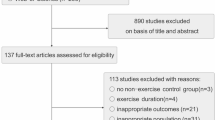Abstract
Introduction
This study aimed to examine the effect of high-load resistance training (HLRT) on bone mineral density (BMD) in patients with osteoporosis and osteopenia using a meta-analysis.
Materials and methods
We searched for randomized controlled trials (RCTs) on HLRT in patients with osteoporosis and osteopenia from medical databases. Our meta-analysis was performed with the primary endpoints being the standardized mean difference (SMD) of the change in BMD of the lumbar spine (LS), femoral neck (FN), and total hip (TH). The robustness of the results was assessed by subgroup analysis. Heterogeneity factors were examined by meta-regression. Publication bias was evaluated using a funnel plot.
Results
We selected nine RCTs, with 259 patients in the HLRT group (women, 55.2%) and 236 patients in the control group (women, 62.7%). The HLRT group showed a significant increase in BMD in the LS [SMD = 1.40, 95% confidence interval (CI) = 0.68–2.12, p < 0.001, I2 = 90%], the FN (SMD = 0.86, 95% CI = 0.05–1.67, p = 0.04, I2 = 92%), and the TH (SMD = 1.26, 95% CI = 0.45–2.08, p = 0.002, I2 = 91%). Subgroup analysis confirmed the robustness of the results only in LS. Total sessions and a high risk of bias were identified as the factors of heterogeneity in FN and TH (p < 0.05). The funnel plot showed asymmetry in all measurement sites.
Conclusion
This study suggested that HLRT can be effective in increasing BMD, mainly of LS, in patients with osteoporosis and osteopenia. However, due to high heterogeneity and publication bias, additional studies with a low risk of bias should be conducted to generalize our findings.




Similar content being viewed by others
References
NIH Consensus Development Panel on Osteoporosis Prevention, Diagnosis, and Therapy (2001) Osteoporosis prevention, diagnosis, and therapy. JAMA 285:785–795
Hernlund E, Svedbom A, Ivergård M, Compston J, Cooper C, Stenmark J, McCloskey EV, Jönsson B, Kanis JA (2013) Osteoporosis in the European Union: medical management, epidemiology and economic burden. A report prepared in collaboration with the International Osteoporosis Foundation (IOF) and the European Federation of Pharmaceutical Industry Associations (EFPIA). Arch Osteoporos 8:136
Odén A, McCloskey EV, Kanis JA, Harvey NC, Johansson H (2015) Burden of high fracture probability worldwide: secular increases 2010–2040. Osteoporos Int 26:2243–2248
Compston J, Cooper A, Cooper C, Gittoes N, Gregson C, Harvey N, Hope S, Kanis JA, McCloskey EV, Poole KES, Reid DM, Selby P, Thompson F, Thurston A, Vine N (2017) UK clinical guideline for the prevention and treatment of osteoporosis. Arch Osteoporos 12:43
Howe TE, Shea B, Dawson LJ, Downie F, Murray A, Ross C, Harbour RT, Caldwell LM, Creed G (2011) Exercise for preventing and treating osteoporosis in postmenopausal women. Cochrane Database Syst Rev 6:CD000333
Zhao R, Zhao M, Xu Z (2015) The effects of differing resistance training modes on the preservation of bone mineral density in postmenopausal women: a meta-analysis. Osteoporos Int 26:1605–1618
Shojaa M, von Stengel S, Kohl M, Schoene D, Kemmler W (2020) Effects of dynamic resistance exercise on bone mineral density in postmenopausal women: a systematic review and meta-analysis with special emphasis on exercise parameters. Osteoporos Int 31:1427–1444
Martyn-St James M, Carroll S (2006) High-intensity resistance training and postmenopausal bone loss: a meta-analysis. Osteoporos Int 17:1225–1240
Raymond MJ, Bramley-Tzerefos RE, Jeffs KJ, Winter A, Holland AE (2013) Systematic review of high-intensity progressive resistance strength training of the lower limb compared with other intensities of strength training in older adults. Arch Phys Med Rehabil 94:1458–1472
Chodzko-Zajko WJ, Proctor DN, Fiatarone Singh MA, Minson CT, Nigg CR, Salem GJ, Skinner JS (2009) American College of Sports Medicine position stand. Exercise and physical activity for older adults. Med Sci Sports Exerc 41:1510–1530
American College of Sports Medicine (2009) American College of Sports Medicine position stand. Progression models in resistance training for healthy adults. Med Sci Sports Exerc 41:687–708
Alajlouni D, Bliuc D, Tran T, Eisman JA, Nguyen TV, Center JR (2020) Decline in muscle strength and performance predicts fracture risk in elderly women and men. J Clin Endocrinol Metab 105:dgaa414
Wright NC, Looker AC, Saag KG, Curtis JR, Delzell ES, Randall S, Dawson-Hughes B (2014) The recent prevalence of osteoporosis and low bone mass in the United States based on bone mineral density at the femoral neck or lumbar spine. J Bone Miner Res 29:2520–2526
Mosti MP, Kaehler N, Stunes AK, Hoff J, Syversen U (2013) Maximal strength training in postmenopausal women with osteoporosis or osteopenia. J Strength Cond Res 27:2879–2886
Watson SL, Weeks BK, Weis LJ, Harding AT, Horan SA, Beck BR (2018) High-intensity resistance and impact training improves bone mineral density and physical function in postmenopausal women with osteopenia and osteoporosis: the LIFTMOR randomized controlled trial. J Bone Miner Res 33:211–220
Hinton PS, Nigh P, Thyfault J (2015) Effectiveness of resistance training or jumping-exercise to increase bone mineral density in men with low bone mass: a 12-month randomized, clinical trial. Bone 79:203–212
Harding AT, Weeks BK, Lambert C, Watson SL, Weis LJ, Beck BR (2020) A comparison of bone-targeted exercise strategies to reduce fracture risk in middle-aged and older men with osteopenia and osteoporosis: LIFTMOR-M semi-randomized controlled trial. J Bone Miner Res 35:1404–1414
Liberati A, Altman DG, Tetzlaff J, Mulrow C, Gøtzsche PC, Ioannidis JP, Clarke M, Devereaux PJ, Kleijnen J, Moher D (2009) The PRISMA statement for reporting systematic reviews and meta-analyses of studies that evaluate health care interventions: explanation and elaboration. Ann Intern Med 151:W65-94
Kanis JA, Melton LJ 3rd, Christiansen C, Johnston CC, Khaltaev N (1994) The diagnosis of osteoporosis. J Bone Miner Res 9:1137–1141
Schoenfeld BJ, Grgic J, Ogborn D, Krieger JW (2017) Strength and hypertrophy adaptations between low- vs. high-load resistance training: a systematic review and meta-analysis. J Strength Cond Res 31:3508–3523
Pasqualini L, Ministrini S, Lombardini R, Bagaglia F, Paltriccia R, Pippi R, Collebrusco L, Reginato E, Sbroma Tomaro E, Marini E, D’Abbondanza M, Scarponi AM, De Feo P, Pirro M (2019) Effects of a 3-month weight-bearing and resistance exercise training on circulating osteogenic cells and bone formation markers in postmenopausal women with low bone mass. Osteoporos Int 30:797–806
Marshall D, Johnell O, Wedel H (1996) Meta-analysis of how well measures of bone mineral density predict occurrence of osteoporotic fractures. BMJ 312:1254–1259
Sterne JAC, Savović J, Page MJ, Elbers RG, Blencowe NS et al (2019) RoB 2: a revised tool for assessing risk of bias in randomised trials. BMJ 366:l4898
Higgins JPT, Li T, Deeks JJ (2020) Chapter 6: choosing effect measures and computing estimates of effect. In: Higgins JPT, Thomas J, Chandler J, Cumpston M, Li T, Page MJ, Welch VA (eds) Cochrane handbook for systematic reviews of interventions version 6.1 (updated September 2020). Cochrane. https://www.training.cochrane.org/handbook. Accessed 2 Jan 2021
Deeks JJ, Higgins JPT, Altman DG. Chapter 10: Analysing data and undertaking meta-analyses. In: Higgins JPT, Thomas J, Chandler J, Cumpston M, Li T, Page MJ, Welch VA (eds) Cochrane handbook for systematic reviews of interventions version 6.1 (updated September 2020). Cochrane. https://www.training.cochrane.org/handbook. Accessed 2 Jan 2021
Kanda Y (2013) Investigation of the freely available easy-to-use software “EZR” for medical statistics. Bone Marrow Transplant 48:452–458
Page MJ, Higgins JPT, Sterne JAC (2020) Chapter 13: Assessing risk of bias due to missing results in a synthesis. In: Higgins JPT, Thomas J, Chandler J, Cumpston M, Li T, Page MJ, Welch VA (eds) Cochrane handbook for systematic reviews of interventions version 6.1 (updated September 2020). Cochrane. https://www.training.cochrane.org/handbook. Accessed 2 Jan 2021
Villareal DT, Steger-May K, Schechtman KB, Yarasheski KE, Brown M, Sinacore DR, Binder EF (2004) Effects of exercise training on bone mineral density in frail older women and men: a randomised controlled trial. Age Ageing 33:309–312
Liu-Ambrose TY, Khan KM, Eng JJ, Heinonen A, McKay HA (2004) Both resistance and agility training increase cortical bone density in 75- to 85-year-old women with low bone mass: a 6-month randomized controlled trial. J Clin Densitom 7:390–398
Basat H, Esmaeilzadeh S, Eskiyurt N (2013) The effects of strengthening and high-impact exercises on bone metabolism and quality of life in postmenopausal women: a randomized controlled trial. J Back Musculoskelet Rehabil 26:427–435
Borba-Pinheiro CJ, Dantas EH, Vale RG, Drigo AJ, Carvalho MC, Tonini T, Meza EI, Figueiredo NM (2016) Resistance training programs on bone related variables and functional independence of postmenopausal women in pharmacological treatment: a randomized controlled trial. Arch Gerontol Geriatr 65:36–44
Kemmler W, Kohl M, Fröhlich M, Jakob F, Engelke K, von Stengel S, Schoene D (2020) Effects of high-intensity resistance training on osteopenia and sarcopenia parameters in older men with osteosarcopenia—one-year results of the randomized controlled Franconian Osteopenia and Sarcopenia Trial (FrOST). J Bone Miner Res 35:1634–1644
Frost HM (2003) Bone’s mechanostat: a 2003 update. Anat Rec 275A:1081–1101
Hsieh YF, Turner CH (2001) Effects of loading frequency on mechanically induced bone formation. J Bone Miner Res 16:918–924
Yeo N, Woo J, Shin KO, Park JY, Kang S (2012) The effects of different exercise intensity on myokine and angiogenesis factors. J Sports Med Phys Fitness 52:448–454
Schroeder ET, Villanueva M, West DD, Phillips SM (2013) Are acute post-resistance exercise increases in testosterone, growth hormone, and IGF-1 necessary to stimulate skeletal muscle anabolism and hypertrophy? Med Sci Sports Exerc 45:2044–2051
Tagliaferri C, Wittrant Y, Davicco MJ, Walrand S, Coxam V (2015) Muscle and bone, two interconnected tissues. Ageing Res Rev 21:55–70
Bemben DA, Bemben MG (2011) Dose-response effect of 40 weeks of resistance training on bone mineral density in older adults. Osteoporos Int 22:179–186
Cussler EC, Lohman TG, Going SB, Houtkooper LB, Metcalfe LL, Flint-Wagner HG, Harris RB, Teixeira PJ (2003) Weight lifted in strength training predicts bone change in postmenopausal women. Med Sci Sports Exerc 35:10–17
Watson SL, Weeks BK, Weis LJ, Horan SA, Beck BR (2015) Heavy resistance training is safe and improves bone, function, and stature in postmenopausal women with low to very low bone mass: novel early findings from the LIFTMOR trial. Osteoporos Int 26:2889–2894
Singh NA, Quine S, Clemson LM, Williams EJ, Williamson DA, Stavrinos TM, Grady JN, Perry TJ, Lloyd BD, Smith EU, Singh MA (2012) Effects of high-intensity progressive resistance training and targeted multidisciplinary treatment of frailty on mortality and nursing home admissions after hip fracture: a randomized controlled trial. J Am Med Dir Assoc 13:24–30
Alba AC, Alexander PE, Chang J, MacIsaac J, DeFry S, Guyatt GH (2016) High statistical heterogeneity is more frequent in meta-analysis of continuous than binary outcomes. J Clin Epidemiol 70:129–135
Martyn-St James M, Carroll S (2010) Effects of different impact exercise modalities on bone mineral density in premenopausal women: a meta-analysis. J Bone Miner Metab 28:251–267
Acknowledgements
We are grateful to Ryoko Ikehara for providing secretarial assistance. This work was supported by Grants-in-Aid from the Ministry of Health, Labour and Welfare (subject no.:19FA1014) and received funding from Tottori University.
Author information
Authors and Affiliations
Contributions
All authors contributed to the study conception and design. Material preparation, data collection, and analysis were performed by YK, TW, and HH. HN and MO contributed to the analysis and interpretation of the data in the study. The first draft of the manuscript was written by YK, and all authors commented on previous versions of the manuscript. All authors read and approved the final manuscript.
Corresponding author
Ethics declarations
Conflict of interest
All authors have no conflicts of interest.
Ethical approval
This article does not contain any studies with human participants or animals performed by any of the authors.
Informed consent
For this type of study formal consent is not required.
Additional information
Publisher's Note
Springer Nature remains neutral with regard to jurisdictional claims in published maps and institutional affiliations.
Supplementary Information
Below is the link to the electronic supplementary material.
About this article
Cite this article
Kitsuda, Y., Wada, T., Noma, H. et al. Impact of high-load resistance training on bone mineral density in osteoporosis and osteopenia: a meta-analysis. J Bone Miner Metab 39, 787–803 (2021). https://doi.org/10.1007/s00774-021-01218-1
Received:
Accepted:
Published:
Issue Date:
DOI: https://doi.org/10.1007/s00774-021-01218-1




